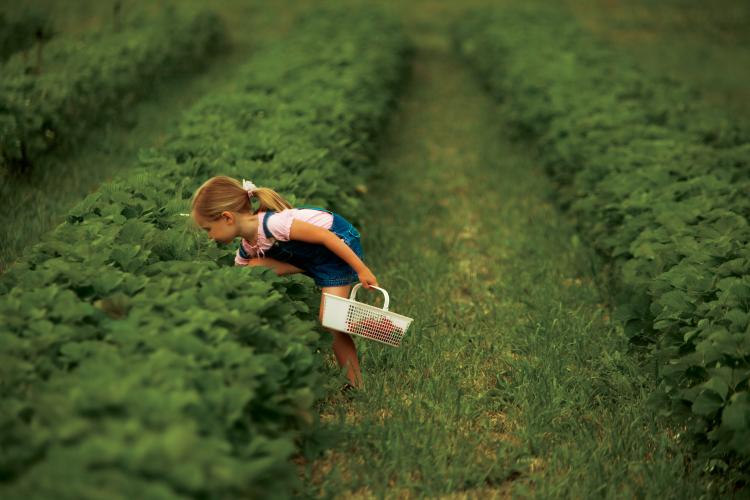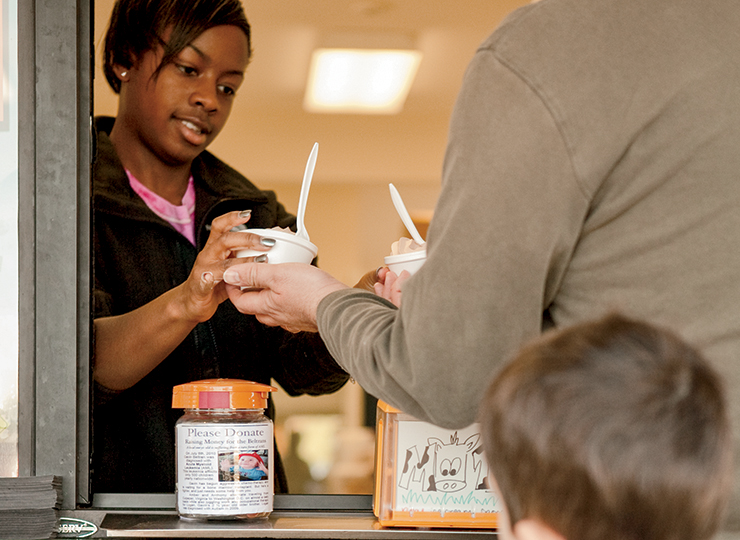Home > Virginia > Virginia Farm to Table > Virginia Consumers Go Local
Virginia Consumers Go Local
In partnership with: Virginia Department of Agriculture and Consumer Services

Agriculture is already Virginia’s largest industry, bringing in more than $55 billion a year. But an exploding new segment could add an additional $1.65 billion to the local economy annually.
Local agriculture – products grown and sold in Virginia – is a rising star in the Commonwealth, says Elaine Lidholm, director of communications for the Virginia Department of Agriculture and Consumer Services.
Many medium-sized farms have opted to decrease acreage and sell directly to the public through agritourism, farmers markets and Community Supported Agriculture, and many restaurant owners are going out of their way to buy local produce. Grocery stores – even large chains – have also started marketing local products.
“We have been telling people for several years, ask for local food, and if enough people ask, the grocery stores will come up with it,” Lidholm says.
A Viable Segment
In addition to row crops, poultry, dairy and beef cattle, Virginia boasts a wide variety of seafood, aquaculture, produce and specialty products that keep local products available year round.
“The hallmark of agriculture here is diversity,” Lidholm says. “We are not a one-product state. We just have a tremendous variety.”
Virginia is ninth in the nation for the number of winter farmers markets, and more and more farmers are beginning to raise and sell beef, lamb and specialty meats, such as bison, directly to local consumers.
Many farmers, like Steve Berryman of College Run Farms in Surry, are finding the local movement to be a viable business.
Berryman and his wife Jordan began raising produce in 1999 after Steve graduated from college. He was raised on a hog and row crop farm, but grain and hog prices were steadily declining, and he decided to explore a new segment of agriculture.
Much of the farm’s business comes from its pick-your-own crops – pumpkins, strawberries and blueberries.
“One of the ways people buy locally here is through agritourism. That’s just an exploding sub segment of the agriculture industry here,” Lidholm says. “It not only gives them a way to buy locally; it also gives them something else, which is a day on the farm, so that’s very popular.”
Berryman still works on his father’s 4,000-acre farm, growing peanuts, cotton, corn, wheat and soybeans, but he says his 35-acre produce operation pays for 75 percent of his family’s expenses.
There are challenges and advantages with both conventional row cropping and small local farming, Berryman says.
“With the other crops that my dad and I grow, you know somebody’s going to be there to buy it, and even though you really can’t demand a price, you know you’re going to get rid of the stuff,” he says. “Whereas my wife and I, we’ve got to work at it and market everything to draw people to the farm.”
Room to diversify
Ken Smith of Remington has been a conventional dairy farmer all his life, but two years ago, he decided to expand into the retail business and sell dairy products directly to the public.
“I always said for years that people drive by my farm, and they recognize me as being a dairy farmer, but they didn’t recognize me as being a provider of food and that my products are on their kitchen table every day,” Smith says.
Smith and his family had 350 dairy cows and farmed 2,500 acres of corn and soybeans, but they needed to expand so their children could make a living in the business as well.

Just getting more cows wasn’t an option, so Smith thought of a way to diversify the farm while also fulfilling his dream of educating consumers about the importance of dairy farmers in their lives – the Moo Thru.
The Moo Thru, located on James Madison Highway in Remington, sells ice cream, milk in glass bottles and milkshakes. Smith raises a herd of 160 grass-fed cows that produce the milk, and people say they can taste the difference in his product.
“I’ve had dozens of people say to me, ‘Why does your milk taste so good?’ Smith says. “I tell them, ‘Because it’s fresh, because it’s grass-fed and because it’ll leave the cow on Tuesday and be in the store on Thursday.’”
Smith says he thinks selling locally, whether it’s at a farmers market, pick-your-own or a retail location like the Moo Thru, is good for farmers, consumers and the local economy.
“It’s a small portion of agriculture, but I think it can be developed,” he says. “I think there’s room for a lot of different avenues of growth. I urge consumers to favor their local markets, processors or producers, so when they drive down the highway, they don’t see house after house and building after building – they’ll see the open green fields and open cropland that’s not all gobbled up by development.”
Find Your Farmer
Local products are available all over the state, Lidholm says. The Virginia Grown program, initiated by the Department of Agriculture and Consumer Services, exists to help consumers find local producers.
The interactive Virginia Grown website and mobile application allow consumers to find farms, restaurants, farmers markets and CSAs that offer local agriculture products in their region.
The Virginia’s Finest Trademark Program highlights top quality Virginia-produced and processed products, including snacks, candy, nuts, cider, meats and produce. These products must be grown or processed in Virginia and must meet or exceed quality standards set by each product’s industry.
Investing in local agriculture products keeps money in the state, Lidholm says.
“The Virginia Cooperative Extension Service did a survey that determined that if every household spent $10 a week on locally grown agricultural products, that would invest $1.65 billion back into the local economy each year.”



